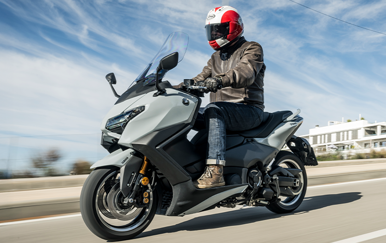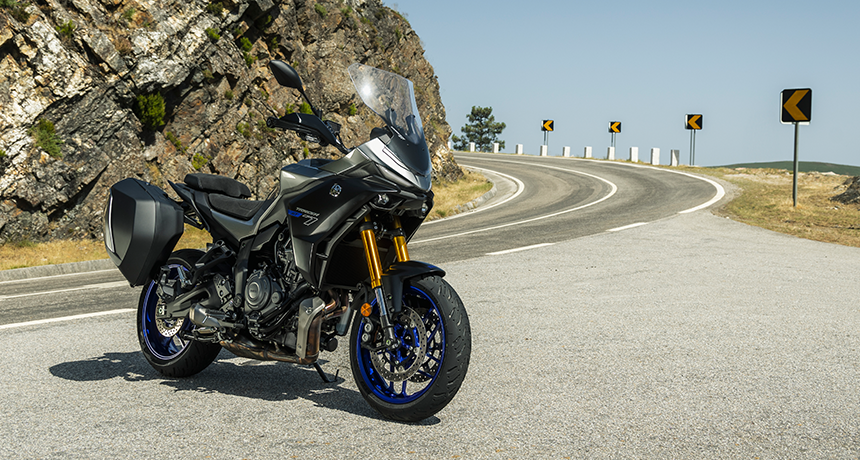
Yamaha’s ‘MT’ or ‘Masters of Torque’ family of bikes have been one of the success stories of modern motorcycling – but nothing stands still forever, hence this new Tracer 7 and Tracer 7 GT for 2025.
The line of modular, affordable in-line twins and triples, which share components and are based on the same grunty ‘Crossplane crank’ engine layout, kicked off at the end of 2013 with the MT-09 roadster triple before being swiftly followed by the lighter, more accessible MT-07 twin in 2014.
Both bikes proved so popular for their blend of entertaining real-world performance, practicality and affordability they spawned a series of spin-offs.
Both begat half-faired sports-tourer versions, first the 2015 Tracer 900 then the 2016 Tracer 700 while there’s also been the retro roadster XSR900 and 700, Ténéré 700 adventure bike and, most recently, the R7 and R9 sportsters.
But the Tracer 7 (as it’s now called) remains one of the most popular of all, is Yamaha UK’s fourth best-selling big bike (behind only the MT-07, Tracer 9 and MT-09) and, in total, over 50,000 Tracer 7s have been sold Europe-wide since its launch.
Which is why, with the arrival of 2025’s new tougher Euro5+ emissions and noise regulations, all of the MT series have received significant updates. The MT-09 was first last year, quickly followed by the MT-07 and Tracer 9 with, now, the Tracer 7 following suit.
We flew out to Porto in northern Portugal for its global press launch and spent a whole day riding both new versions across a variety of roads totalling over 170 km in the spectacular region of the Duoro river valley to explore its abilities but first let’s look into exactly what is new.
What's new for the Yamaha Tracer 7 and 7 GT?
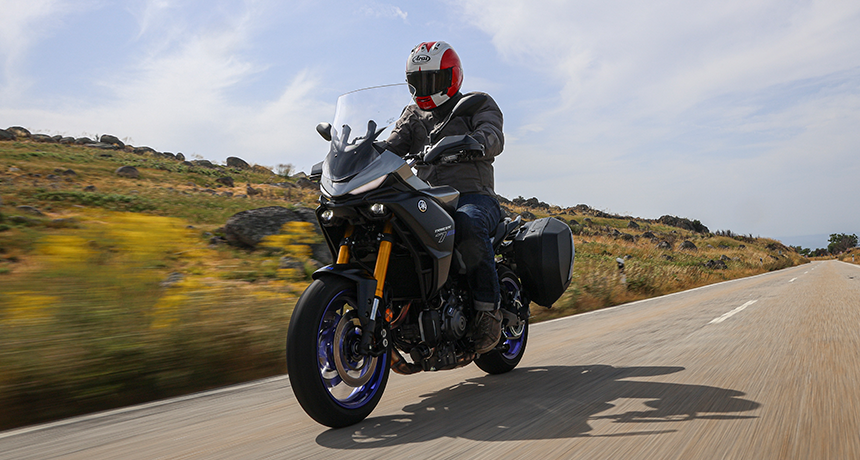
First things first: as before, there’s not just ONE new Tracer 7 – but TWO: The basic Tracer 7 and an upspecced, more premium, more dedicated touring version, the Tracer 7 GT.
Both share the same basic mechanicals, upgrades and core equipment with the GT distinguished by a different screen, seat, standard luggage and a few more premium details and finishes.
The trigger for both, of course, was Euro5+. So, to align with that the new Tracers are based on the updated CP2 twin-cylinder engine as already introduced in the 2025 MT-07.
The key change with that was the switch to an electronic ‘ride-by-wire’ throttle which, along with some minor intake changes, allowed retuning to meet the new emissions and noise regs.
The resulting power and torque curves are actually a slight improvement on the old although you’d struggle to notice. Ride by wire also allows the new Tracer 7s to now also have the new full colour 5in TFT dash and new generation switchgear, as also introduced on the 2025 MT family, standard cruise control and an optional quickshifter.
But that’s just the start.
As Yamaha Europe’s Powered Two Wheeler Product Manager, James McCombe, explained at the bikes’ technical presentation, this time round, for the Tracer 7’s fourth generation (the previous updates coming in 2020 and 2023), the company was also keen to reposition the model slightly – to retain its sporting ability but to increase its touring ability.
To achieve that, some fundamental changes have occurred. The Tracer 7 is very much a ‘European Yamaha’ with the bulk of its sales here.
As a result, it’s ‘defined’ as Yamaha Motor Europe (YME)’s HQ in Amsterdam, designed at the YME Design Centre in Milan and built at YME’s production facility in Saint Quentin in Northern France (along with the Ténéré 700, XMAX scooter and others).
The key elements of that redesign were to firstly, as mentioned, retain the now Euro5+ compliant MT-07/CP2 powertrain but then, crucially, to also provide a more touring-friendly chassis, closer to that of the Tracer 9 and also a more ‘mature’ aesthetic with revised styling, added comfort and more premium touches.
To deliver exactly that, the new Tracer 7 is not only longer, roomier and even slightly heavier than before, but it’s also more comfortable, more adjustable (with both an adjustable seat and screen) and has higher quality and more premium features throughout, ranging not only from the new dash and switchgear, to new inverted forks, upgraded now radial-mount brake calipers and even higher quality Michelin Pilot Road GT6 tyres.
Nor does it end there.
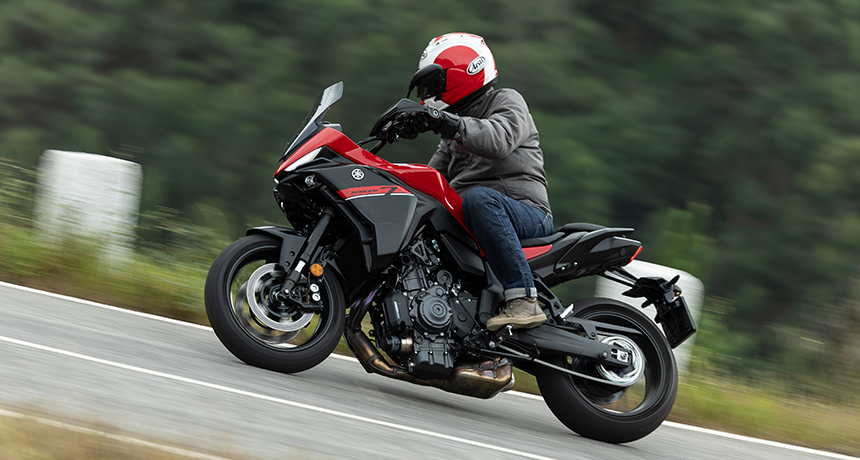
Aside from offering two distinct models with two very different spec levels – the standard Tracer 7 has a much lower (although still manually adjustable) sports screen, thinner, lower saddle and different finishes.
Meanwhile, the GT has a 90mm taller (and 1mm thicker) touring screen, standard 30-litre colour-matched panniers, centre stand, 15mm thicker saddle and rear remote preload adjusting knob) – a large range of further accessories are available organised into three distinct ‘packs’, named Sport, Tourer and Urban.
And, if all that still isn’t enough for you to easily tell the models apart, there are new colours, too. The standard Tracer 7 comes in gloss ‘Redline’ or ‘Midnight Black’, the GT comes in satin ‘Icon Performance or ‘Tech Black’, had gold finished forks and comes with more premium badging.
Price and Availability - Yamaha Tracer 7 and 7 GT
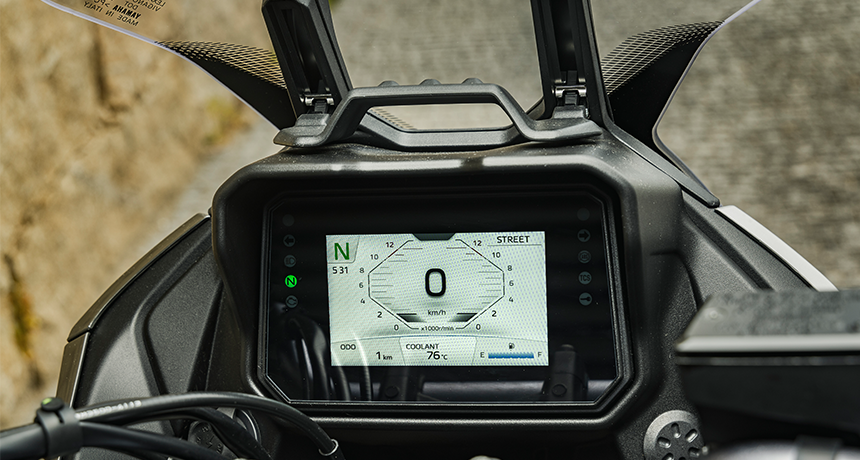
Tracer 7 and 7 GT, £8,804 and £10,104
On sale and available at dealers now (July 2025), the new Yamaha Tracer 7 is priced at £8,804 on the road with the upspecced GT costing £10,104.
For those who opt for a monthly PCP deal, for the Tracer 7 sourced from Yamaha UK you’re looking at £95.99/month over 36 months with a deposit of £2500, 9.4% APR and a £4,335 final payment.
For the Tracer 7 GT you’re looking at £115.04/month over 36 months with a deposit of £2750, also 9.4% APR and a £4,930 final payment, although, obviously, other permutations are possible.
By our reckoning, although the GT’s price is up by around £300, the standard model’s is little changed and both, considering the improvement in spec (brakes, forks), equipment (TFT, switchgear) and quality, they both represent really good value.
What’s more, considering how both bikes have also been positioned more closely to the latest Tracer 9s, particularly in terms of their more roomy, more mature riding positions and premium feel, those prices also question, slightly, how much you might want to ultimately progress to the 900cc versions.
Don’t forget, the updated 2025 Tracer 9 now starts at £11,304, £2500 more than the 7. The new Tracer 9 GT, meanwhile, costs £14,354 while the top spec Tracer 9 GT+, although admittedly slathered in high tech including radar-controlled braking and semi-active suspension, now is a whopping £17,004, almost £7000 more than the 7 GT.
In short, you have to ask yourself, ‘how much Tracer do you actually want?’
Yamaha Tracer 7 and 7 GT Engine: Euro 5+ and other updates
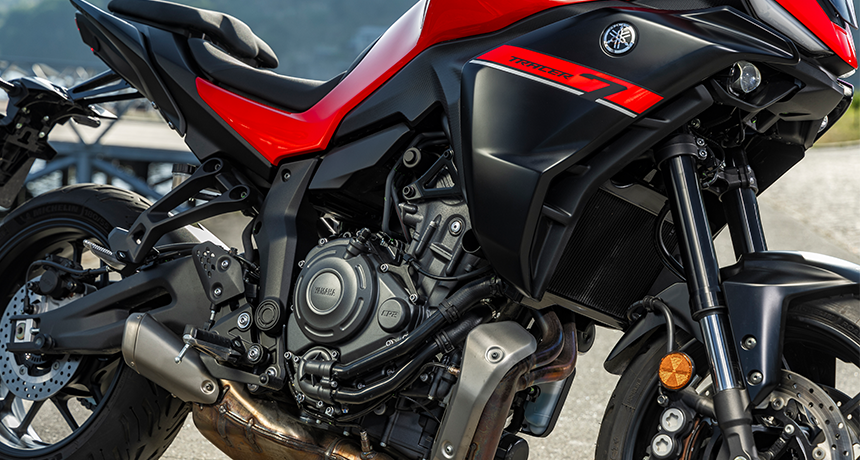
689cc Twin-Cylinder | 54 kw / 72.4 bhp | 68 Nm | 4T 4V DOHC | 3 modes
The key trigger for the Tracer 7 revisions is, of course, the new Euro5+ regulations. To meet these, its familiar 689cc ‘CP2’ parallel twin engine has undergone a number of revisions. Fortunately for Yamaha, as the Tracer is part of an extended MT family, those revisions had already made on the 2025 MT-07 on which the Tracer is based.
The key change is the switch to an electronic ‘ride-by-wire’ throttle which allows, along with subtle intake changes, the modifications necessary to meet the new regulations. Power and torque are essentially unchanged. The ride-by-wire also allows the new dash and switchgear and the potential to fit an optional quickshifter.
The gearbox has also been revised very slightly for an improved shifting action plus there’s an improved generator for a more stable power supply’ to accessories.
Electronics-wise, there are two main standard riding modes, Street and Sport, with an additional Custom mode plus also switchable traction control.
However, as I take the GT version for our first leg of our ride, it’s not the engine, but the new bikes’ revised riding positions and equipment that is most conspicuous.
With a taller, now-two piece seat, higher, wider handlebar (the grips are now 35mm further apart and 30mm higher with the dash positioned higher to match) and simply humungous adjustable screen (which is a full 90mm taller than the outgoing GT) your immediate impression of the new Tracer 7 GT is of a much more substantial, roomier machine.
On the old Tracer 7, at 6’3”, I was always conscious of being on a slightly dinky, compact, or junior machine. Not so on the new one.
On top of that, it also comes over as a more premium one, too.
The new dash and switchgear, already familiar from the preceding MT-07, is classy and effective, the new premium finishes and details (such as the GT’s raised tank badge, ‘shading’ on the screen and satin pain finish), give a quality ‘vibe’ the previous more budget-feeling model lacked.
Additionally, with a one litre larger tank and slightly heavier (500g) all up weight there’s an extra ‘substance’ here, too – not that the new Tracer is at all more awkward or intimidating to man-handle around.
But as I thumb the starter, am rewarded with the MT’s unchanged twin cylinder bark, prod into first and easily, effortlessly trundle away from our riverside hotel before heading into the hairpin-strewn mountains, most of the rest of the new Tracer 7 is as familiar and friendly as before.
The grunty ‘Crossplane’ motor pulls happily and effortlessly from almost any revs, the throttle response, as you might expect from a bike with 10 years of development behind it, is immaculate, the clutch is light and crisp, the gearchange, although a little ‘tight’ and new, is more than adequate and the whole bike feels neutral and intuitive.
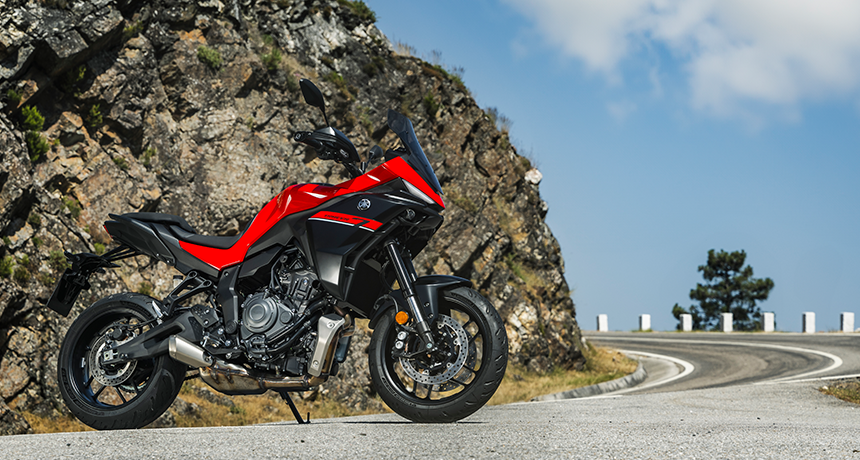
We hit the open roads, turn towards the mountains and are quickly able to give the new Tracer its ‘head’. Although significantly updated, this fourth generation version of the CP2 twin feels almost completely familiar.
There’s that gurgly twin cylinder pull from low down; a completely progressive pull through the mid-range; an entertaining aural soundtrack coming up through the tank and, at the top end, approaching 8000rpm, more than enough power to entertain.
I start off in Street mode before, after a few miles, switching easily via a prod of the Mode button on the right switchpod followed by a swift ‘throttle off’, switching into Sport. It sharpens things up a touch in terms of throttle response but is less distinctive than some and for the most part, the slightly smoother Street is sufficient.
Its 72 peak horsepower is familiar and sufficient, too – certainly for riding solo, and whether merely travelling or tempting to ride aggressively from hairpin to hair pin. On the whole there are no complaints, especially in isolation and it remains a great motor.
I do wonder slightly though, having recently ridden the MT-07 version back-to-back with Honda’s latest 90bhp 750 Hornet and Suzuki’s wondrously grunty GSX-8S, whether the Yamaha twin is now starting to feel a little old and falling behind.
For now, however, that doesn’t matter. The Tracer 7’s powerplant is fine and fun in this role and, besides, Honda nor Suzuki yet make sports-tourer versions of their twins…
How does the Yamaha Tracer 7 handle?

203/212 kg | 830/850mm seat | 1,495mm wheelbase | 135mm ground clearance | USD telescopic forks & Monoshock rear
The new Tracer’s handling is more than good enough, too – in fact, I’ll go further than that. While the old version was in no way flawed it did come over, for big 'ol me at least, as slightly diminutive and basic – not anymore.
Not only has the frame been thoroughly revised to become 13% more rigid overall, there’s a new aluminium swing arm which is a full 40mm longer than the old Tracer 7 (and 100mm longer than that of the MT-07) plus there’s the aforementioned new suspension and brakes – namely beefier, preload and rebound adjustable KYB inverted forks (finished in gold on the GT) plus new, now radial-mount four-piston caliper brakes.
The result adds not only a sense of greater substance, a more ‘grown up’ feel and added stability, but a more cultured and classy ride and braking with extra power and feel – all of which comes to the fore through the Duoro river canyon hairpins.
‘Is it less nimble’, I can hear you wondering? Possibly, but not really in any discernible, significant way. Instead it all adds up to a brilliant cohesive sports tourer package that manages the rare trick of being, at once, affordable but premium feeling, and comfortable and stable, yet also sporty and sweet handling. The tyres, by the way, Michelin’s Pilot Road GT6, are great, too.
But of course, this test – and launch – is not all just about the new Tracer 7 GT. There are two models to consider so, at the first photo stop high in the mountains, I take the opportunity to swap from the GT to the new base model and see what difference it makes.
Paint and rear preload adjuster (oh, and centre stand) aside, the biggest immediate difference is the screen. Although both use the same two-way, manual height adjustment mechanism (through 60mm), the GT’s screen is so big (and effective, it has to be said) that the much smaller almost ‘flyscreen’ of the standard bike seems miniscule. (That said, if that’s an issue, you can add a taller one through the various accessory packs).
Nor is it quite the only difference. Although mechanically virtually identical, the ‘stocker’ is also lighter and, without the big screen, taller seat and panniers, feels lither, sportier, more compact. In reality, it’s not by much, of course. But at the end of the day I couldn’t help wondering if that, although I loved the GT’s big screen, at £1300 less, the base model might be the better buy and I could probably get enough ‘touring’ comfort by adding a pack or just a screen and top case instead…
Features of the Yamaha Tracer 7 and 7 GT

Dash: 5” TFT dash | three modes | 18 L tank | Traction Control | Cruise control | Adjustable screen
One of the other things that impressed most about Yamaha’s two new Tracer 7s was their improved equipment and spec levels, which on both models, considering the price, Yamaha seems to have pitched ‘just right’.
Both are improved, with the two sharing cruise control and the familiar new 5in TFT dash and switchgear from the MT-07. While not perfect – the dash digits are sometimes a little small, the switchgear’s new ‘rocker’ indicator switch is a little irritating – they are both a substantial upgrade over the old.
Rider electronics are OK, the new adjustable screens are excellent, the new two-piece saddles are both height adjustable too; the brake and suspension upgrades are a no-brainer and the GT also benefits from a rear preload adjuster knob, centre stand and, of course, those smart, colour-matched, 30-litre side cases.
Neither seems lacking in anything, neither, too, seems bestowed with unnecessary gimmicks which might add to the price.
Sports or touring: Which model should I choose?
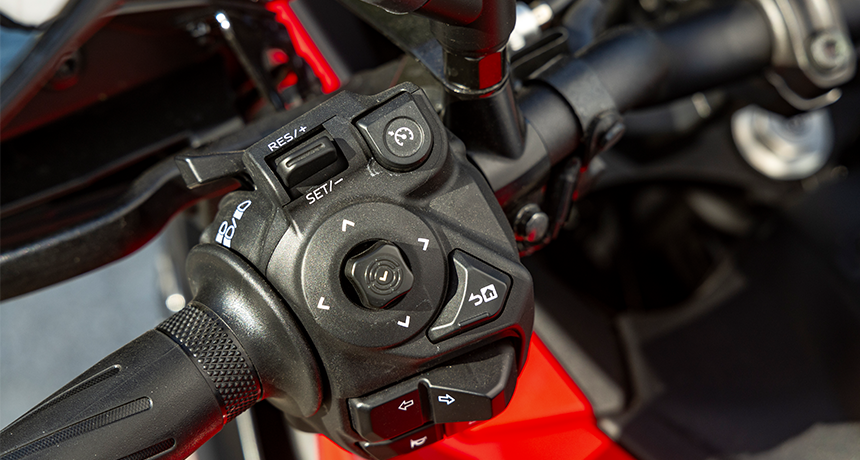
Rarely are bike choices so distinct. The new Tracer 7 comes in two guises: the cheaper, more basic, arguably more sporty base model and the upspecced, more premium, more comfortable and more lavishly equipped GT version, with all their differences detailed elsewhere.
There are no doubts that, at a very affordable £10,104, the GT makes a compelling argument. It’s a great performer, has grown up, has more style and substance than ever and also delivers all you really need – so much so, in fact, that it puts into question the £17,000 price of Yamaha’s equally new Tracer 9GT+. Instead, the only question mark I have is that if you do a lot of two-up riding you might want a little more performance.
The base version is arguably even more compelling. If you don’t need panniers and premium bits, at £8804 it really does it all and will leave you with a big smile on your face, although I, personally, would also invest in an accessory taller screen and maybe a tank bag or top case.
Pros
-
Still excellent CP2 engine
-
All round ability and value
-
Larger stature and improved spec
Cons
-
Looks not to everyone’s taste
-
Engine now a touch old and underpowered
-
Niggly indicator switch
Verdict: Yamaha Tracer 7 and 7 GT 2025
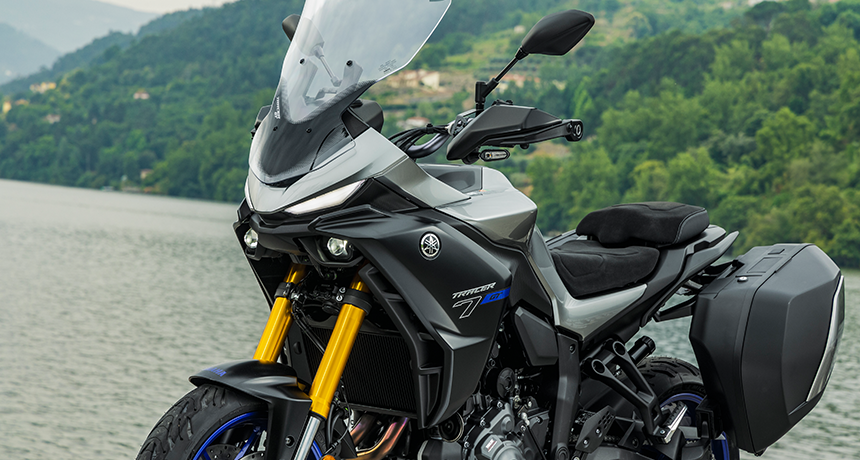
The king is dead – long live the king. In other words, the Tracer has been the definitive and best-selling mid-range sports-tourer ever since the original was launched in 2016. Three generations on it still is – with this incarnation a significant step-up in terms of its roominess, stature and premium spec.
Yes, the CP2 engine is starting to feel a touch long in the tooth and hasn’t quite the dominant peak power of the original (it’s now bettered by Triumph’s Tiger Sport 660 and Honda and Suzuki will surely offer rivals based on their Hornet 750 and GSX-8s roadsters soon), but as an overall package that’s at once effective, fun, classy and affordable, the Yamaha remains on top.
Which you go for – base or GT – is, of course, up to you. But the brilliance even here is that you get that choice. Me? I’m tempted by the GT, which is so good it makes me wonder if I’d rather have it and save 1000s over the Tracer 9, but I’m also thinking I could save even more with the base version and just add a big screen and some boxes!
Thanks to Yamaha for having us on the European launch, check the full specs and information on the Yamaha UK website.




